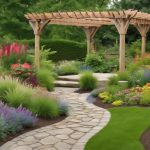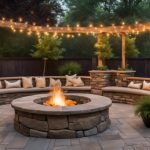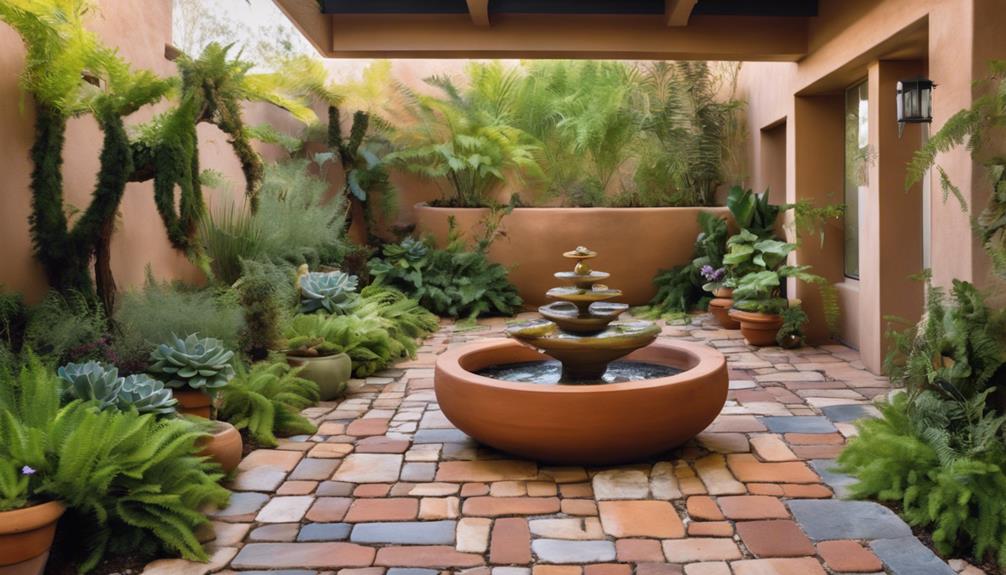
What Plants Enhance Your Hardscaping Features?
24 October 2024
What Is Hardscaping for Outdoor Entertainment Spaces?
24 October 2024To enhance your hardscaping design, select plants that complement the structure while providing visual interest.
Choose hardy species suited to your climate, such as drought-tolerant plants for arid regions or native varieties that flourish locally.
Incorporating a mix of textures—such as ornamental grasses, flowering shrubs, and evergreen trees—creates depth and softens hard surfaces.
Furthermore, consider maintenance requirements and seasonal variety to ensure year-round appeal.
The right plant selections not only enrich aesthetics but also contribute to ecological balance.
Discover more strategies to elevate your landscape while ensuring harmony and sustainability.
Hardscaping Plant Selection Tips
When selecting plants for hardscaping, it is crucial to take into account the specific climate conditions of your area to ensure successful growth and longevity.
Furthermore, choosing plants with complementary textures can enhance the overall aesthetic appeal, creating a harmonious balance between hardscape elements and greenery.
Thoughtful selection not only increases visual interest but also promotes a thriving landscape.
Consider Climate Conditions
Selecting the right plants for hardscaping requires a keen awareness of climate conditions, as these factors greatly influence plant health and aesthetic appeal.
Understanding your local climate, including temperature ranges, humidity levels, and precipitation patterns, is essential for making informed selections. For instance, arid regions benefit from drought-tolerant species, while more temperate zones can support a diverse palette.
Furthermore, consider microclimates within your landscape, such as areas shaded by structures or exposed to wind. This nuanced approach allows for the selection of plants that not only thrive but also enhance the overall design.
Ultimately, aligning plant choices with climate conditions fosters resilience, ensuring that your hardscaping remains visually enchanting and sustainable throughout the seasons.
Choose Complementary Textures
Understanding climate conditions lays the groundwork for effective plant selection; however, just as essential is the consideration of texture in your hardscaping design.
Textures can greatly influence the visual harmony and overall aesthetic appeal of your landscape. When selecting plants, aim for a variety of textures—smooth, coarse, spiky, or feathery—that will complement hard surfaces like stone, brick, or concrete.
For instance, pairing the ruggedness of ornamental grasses with the sleek lines of modern paving creates a striking contrast. Furthermore, layering plants with differing textures can enhance depth and dimension.
Ultimately, thoughtful texture selection not only enriches your hardscape but also fosters a cohesive and inviting outdoor space, elevating the entire design to an artful expression of nature and architecture.
Plant Growth Requirements
Understanding plant growth requirements is vital for successful hardscaping.
Key factors such as soil pH levels, sunlight exposure, and the size and growth habit of plants play a critical role in their health and integration into the landscape.
Soil Ph Levels
How does soil pH influence plant growth? Soil pH plays a vital role in nutrient availability, microbial activity, and overall plant health. It dictates how well plants can absorb essential nutrients, as certain elements are more accessible at specific pH levels.
For optimal growth, understanding soil pH is significant.
Key considerations regarding soil pH include:
- Nutrient Uptake: Most nutrients are available between pH 6.0 and 7.5.
- Microbial Activity: Beneficial soil organisms thrive at neutral pH, aiding in nutrient cycling.
- Plant Selection: Some plants prefer acidic soils, whilst others flourish in alkaline conditions.
A thorough assessment of soil pH will inform suitable plant choices and enhance the effectiveness of your hard landscaping design.
Sunlight Exposure Requirements
Maximising sunlight exposure is crucial for plant growth, as it directly influences photosynthesis and overall vitality.
Understanding the different sunlight requirements of plants allows for strategic placement within hardscaping designs, ensuring ideal growth and aesthetic appeal.
Consider the following categories when selecting plants:
- Full Sun: Requires six or more hours of direct sunlight daily, ideal for vibrant flowers and robust foliage.
- Partial Shade: Thrives in three to six hours of sunlight, suitable for areas that receive dappled light.
- Full Shade: Needs less than three hours of sunlight, perfect for densely shaded gardens where other plants struggle.
Plant Size and Growth Habit
When selecting plants for hardscaping, considering plant size and growth habit is essential for creating a balanced and harmonious landscape.
The interplay of different plant sizes and forms can enhance visual interest and structure within your design.
Key factors to keep in mind include:
- Mature Height: Ensure that taller plants do not overshadow smaller ones, maintaining a clear sightline.
- Spread: Take into account the width of plants to prevent overcrowding, which can lead to competition for resources.
- Growth Rate: Opt for a mix of fast and slow growers to allow for dynamic layering over time.
Select Compatible Plant Varieties
To achieve a harmonious landscape, it is vital to assess your site's specific conditions, including soil type, sunlight, and moisture levels.
Implementing mulch can greatly aid in moisture retention, promoting healthier plant growth.
Furthermore, employing layered planting strategies can enhance visual interest while ensuring that plant varieties complement one another effectively.
Assess Your Landscape's Conditions
How can you ensure that the plants you choose will flourish in your hardscaped environment? A comprehensive assessment of your landscape's conditions is crucial.
Key factors such as soil type, sunlight exposure, and moisture availability play vital roles in determining plant compatibility.
- Soil Type: Assess whether your soil is sandy, clay, or loamy, as this affects drainage and nutrient retention.
- Sunlight Exposure: Identify areas of full sun, partial shade, or full shade to match plants with their light requirements.
- Moisture Availability: Consider the watering needs of your plants, ensuring they align with the natural moisture levels of your landscape.
Mulch for Moisture Retention
Selecting the right plant types is essential for maximising moisture retention in hardscaped areas, ensuring that your landscape thrives despite potential challenges.
Utilising effective mulch in conjunction with compatible plants can notably improve moisture conservation.
Consider the following plant types that complement mulch applications:
- Sedum: Drought-tolerant and resilient, these succulent plants thrive in various conditions while retaining soil moisture.
- Lavandula (Lavender): Known for its fragrant blooms, lavender requires minimal water and can thrive in well-drained soils, making it ideal for hardscaping.
- Achillea millefolium (Yarrow): This hardy perennial not only adds vibrant colour but also helps to stabilise soil moisture levels.
Layered Planting Strategies
Layered planting strategies are frequently employed to create visually appealing and functional landscapes in hardscaped environments.
By selecting compatible plant varieties, designers can achieve a dynamic interplay of colours, textures, and heights, enhancing the overall aesthetic while promoting ecological balance.
Consider the following plant combinations:
- Tall Grasses: Use ornamental grasses like Miscanthus or Panicum for vertical interest.
- Medium Shrubs: Incorporate flowering shrubs such as Hydrangea or Spiraea to provide structure and seasonal colour.
- Low Groundcovers: Choose low-growing plants like Creeping Thyme or Sedum to fill in gaps and suppress weeds.
This strategic layering not only draws the eye but also fosters biodiversity, ensuring that your hardscaped designs remain vibrant and sustainable throughout the seasons.
Aesthetic Appeal and Tranquility
A well-designed hardscape can significantly enhance the aesthetic appeal and tranquillity of outdoor spaces, with the appropriate plant selections playing a crucial role. Carefully chosen plants not only soften hard surfaces but also introduce colour, texture, and movement, fostering a serene environment. Integrating diverse plant types can create visual focal points, enhancing the overall design.
| Plant Type | Aesthetic Qualities | Tranquillity Factor |
|---|---|---|
| Ornamental Grasses | Graceful movement | Calming presence |
| Flowering Shrubs | Vibrant colours | Inviting atmosphere |
| Evergreen Trees | Year-round structure | Sense of permanence |
These elements combine to create spaces that promote relaxation and enjoyment, making the outdoor experience both visually appealing and emotionally soothing.
Garden Design Implementation Techniques
Effective garden design implementation techniques are vital for creating a harmonious outdoor space that complements hard landscaping elements.
This includes mastering vertical garden installation, thoughtfully integrating water features with plants, and employing strategic garden lighting to enhance the overall ambience.
Each technique plays a key role in maximising both aesthetics and functionality in landscape design.
Vertical Garden Installation Techniques
Numerous techniques can be employed to successfully install a vertical garden, each tailored to enhance both aesthetics and functionality.
Selecting the appropriate method is essential for achieving a sustainable and visually engaging design.
- Modular Systems: Utilise pre-planted panels that can be easily mounted and replaced, allowing for flexibility in design.
- Trellis Structures: Create a framework that supports climbing plants, enhancing verticality while adding depth to the design.
- Hydroponic Solutions: Implement soil-less growing systems that optimise space and facilitate efficient water management.
Each technique offers distinct advantages, catering to diverse plant types and environmental conditions.
Mastery of these installation techniques guarantees a thriving vertical garden that harmonises with hardscaping elements.
Water Feature Plant Integration
Incorporating plants into water features can considerably enhance the overall aesthetic and ecological value of a garden. Thoughtfully selected aquatic and marginal plants not only improve visual appeal but also support local biodiversity.
When integrating plants, consider the following strategies:
- Choose native species: Native plants are better suited to local climates and require less maintenance, ultimately thriving in aquatic conditions.
- Layering techniques: Position taller plants at the back and shorter ones in the foreground to create depth and visual interest.
- Seasonal variety: Select a mix of plants that bloom at different times to ensure year-round colour and texture.
Effective plant integration transforms water features into dynamic ecosystems, enriching both the landscape and the overall experience of the garden.
Garden Lighting Integration Techniques
A well-designed garden lighting plan not only enhances the aesthetic appeal of outdoor spaces but also improves safety and functionality after dark.
Integrating lighting into your hard landscaping design requires a thoughtful approach to increase visual interest and usability.
Consider these techniques for ideal integration:
- Layered Lighting: Combine ambient, task, and accent lighting to create depth and highlight key features.
- Pathway Illumination: Utilise subtle lighting along pathways and steps to ensure safe navigation while adding charm.
- Highlighting Focal Points: Direct light towards architectural elements or significant plants, drawing attention and creating dramatic contrasts.
Plant Compatibility Issues
Understanding plant compatibility is essential for successful hardscaping, as it involves addressing issues such as invasive species management and the selection of pest-resistant varieties.
Furthermore, incorporating appropriate soil amendments can improve overall plant health and ensure a harmonious landscape design.
Invasive Species Management Strategies
Managing invasive species is critical for maintaining the ecological balance in hardscaped environments. Effective strategies for managing these plants can greatly improve the compatibility of your landscape design.
To ensure a harmonious integration of flora, consider the following approaches:
- Regular Monitoring: Conduct routine assessments to identify and address invasive species before they establish dominance.
- Selective Removal: Use targeted removal techniques that minimise disturbance to native plants, ensuring the preservation of beneficial species.
- Reinforcement with Native Plants: Introduce native species that outcompete invasives, promoting biodiversity and resilience within the ecosystem.
Implementing these strategies not only safeguards the integrity of your hardscaping design but also contributes to the overall health of the local environment.
Pest-Resistant Plant Varieties
Incorporating pest-resistant plant varieties into hardscaping designs can greatly enhance the sustainability and longevity of landscaped areas.
These plants not only reduce the need for chemical pesticides but also contribute to a more balanced ecosystem. Selecting the appropriate pest-resistant species is crucial for optimal plant compatibility and resilience.
Consider the following options:
- Lavender (Lavandula): Its aromatic oils deter many pests while attracting pollinators.
- Marigold (Tagetes): Known for its ability to repel nematodes, making it a robust companion plant.
- Sedum (Sedum spp.): This succulent variety thrives in diverse conditions and is less prone to pests.
Integrating these varieties into your hardscaping will foster a healthier landscape, ensuring both aesthetic appeal and functional integrity.
Soil Amendments for Plant Health
Healthy soil is the foundation for thriving plants, and the integration of appropriate soil amendments can markedly influence plant compatibility and general health.
Utilising the right amendments ensures a balanced nutrient profile and ideal pH levels, which are critical for plant vigour and resilience.
Consider these vital soil amendments:
- Organic Matter: Improves soil structure, moisture retention, and microbial activity.
- Lime: Adjusts soil pH, promoting nutrient availability for acid-sensitive plants.
- Sulphur: Lowers pH for plants requiring an acidic environment, thereby promoting compatibility among species.
Why Choose TKL Birmingham Gardener
Choosing the right gardener can significantly influence the success of your hardscaping projects, and TKL Birmingham Gardener emerges as a premier choice.
With a commitment to excellence, TKL Birmingham Gardener combines horticultural expertise with a comprehensive understanding of hardscaping principles. Their team meticulously assesses site conditions, ensuring that plant selections harmonise with hardscape features while flourishing in the given environment.
Furthermore, their emphasis on sustainable practices promotes long-term health and aesthetic appeal. By employing advanced design techniques and a diverse range of plant varieties, TKL Birmingham Gardener creates harmonious landscapes that are both visually stunning and functionally robust.
This dedication to quality and attention to detail makes them an invaluable partner in bringing your landscape vision to life.
Common Planting Mistakes to Avoid
A successful planting scheme requires careful thought and planning; however, many gardeners fall prey to common mistakes that can undermine their efforts.
One frequent error is poor plant selection, where species are chosen without regard for their growth habits or suitability to the local climate.
Additionally, neglecting soil preparation can lead to inadequate drainage and nutrient deficiencies, stunting plant growth.
Overcrowding is another pitfall; plants need adequate space to thrive and reach their full potential.
Furthermore, failing to take seasonal changes into account can result in a landscape that lacks visual interest throughout the year.
Finally, inconsistent maintenance routines can allow invasive species to dominate, diminishing the aesthetic and structural integrity of your design.
Avoiding these mistakes is vital for achieving mastery in planting.
Final Thoughts on Plant Choices
Making informed plant choices is crucial for creating a successful landscape that harmonises with hardscaping elements. Selecting the right plants enhances visual appeal, optimises functionality, and promotes sustainability.
Consider the following key factors when making your selections:
- Climate Compatibility: Choose plants that thrive in your local climate to ensure resilience and minimal maintenance.
- Scale and Proportion: Select plants that complement the size and scale of your hardscaping features, creating a balanced aesthetic.
- Seasonal Interest: Opt for a variety of plants that provide visual interest throughout the seasons, enriching your landscape all year round.



